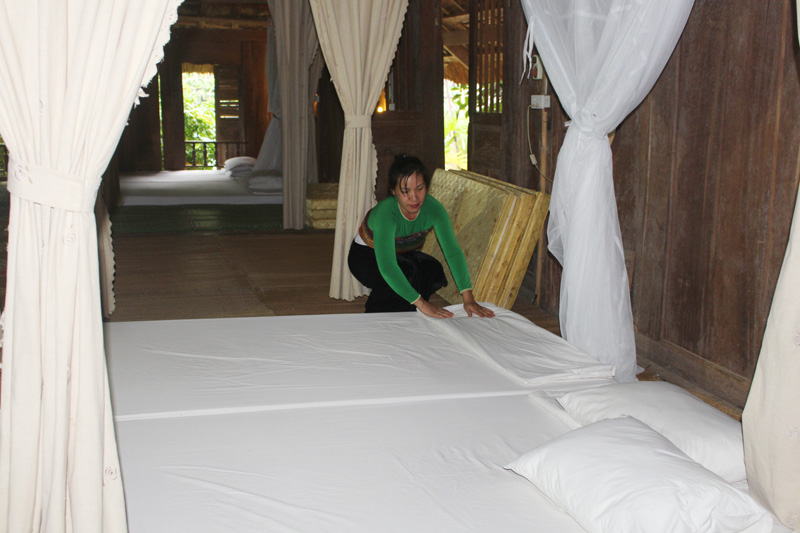
(HBO) – Untouched rustic Mai Hich commune, which is emblazoned with ripen rice terraces surrounded by mountain ranges and trails covered by white smoke streaking from local houses’ roofs, has grown in stature among domestic and international visitors in recent years.
Photo:
Homestay Minh Tho in Hich 2 village, Mai Hich commune (Mai Chau district) is a
favourable accommodation among travel companies.
Community-based
tourism has undergone positive changes and brought stable income to local
people. There are seven households offering homestay services and three
villages developing community-based tourism, comprising Hich 1, Hich 2 and Cha
Lang. In the first half of the year, the commune welcomed over 1,600 visitors, 900
of whom are foreigners, and raked in nearly 600 million VND in tourism revenue.
The commune has mobilised locals to promote community-based tourism after
seeing its economic benefits. It has also asked the locals to pay attention to
ensuring environmental hygiene to lure more holiday-makers to the locality.
Connections between villages and tourist attractions help visitors have
brilliant experience during their stay.
Ha Cong Minh, a homestay owner in Hich 2 village, said: "How to make tourists
feel comfortable and enjoyable is what we care. We have teamed up with travel
agents to set up tours for visitors to go sightseeing, enjoy stunning views of
waterfalls and landscape of rural areas as well as involve in local activities
like rice harvesting, fishing, brocading and experience traditional dishes and
cultural exchange.
The Centre for Community Health and Development (COHED) has supported homestay
service providers in Hich 2 village with necessary skills and knowledge as well
as capital to develop community-based tourism since 2010. The commune is home
to 120 Thai ethnic families, who have preserved nearly 90 percent of their
traditional stilt houses.
Bestowed with natural landscapes and tourism investment, coupled with local
hospitality, Mai Hich has become an attractive draw for tourists to discover
spectacular sceneries and ethnic traditional culture. It is expected to make
community-based tourism a major currency earner of the commune./.
A diverse chain of eco-tourism and resort destinations concentrated in Hoa Binh city and the districts of Tan Lac, Da Bac, and Luong Son… Along with the launch of several key high-quality resort tourism projects, these developments have reshaped the landscape and enhanced the appeal of Hoa Binh as a travel destination.
Boasting diverse terrain, a mild climate, and rich natural resources, Cao Phong district is increasingly asserting its place on Vietnam’s tourism map, attracting both domestic and foreign visitors. The district is renowned for its stunning landscapes, majestic mountains, a crystal-clear hydropower lake, and the unique cultural identity of local ethnic groups.
With its pristine landscapes, unique cultural heritage of Muong ethnic minority, and an expanding range of visitor experiences, Tan Lac district of Hoa Binh has fast become a captivating destination for both domestic and international tourists.
Until now, Sung village in Cao Son commune, Da Bac district remains the only Dao ethnic community in Hoa Binh province to develop a community-based tourism model. Beyond its untouched natural landscapes, cultural identity serves as the cornerstone attraction for visitors.
Alongside the diverse cultural identities of the Kinh, Muong, Tay, Thai, Dao, and Mong ethnic people, Hoa Binh province is also renowned as the "capital" of the northwestern Vietnamese cuisine, offering unique and distinctive dishes. At festivals, during Lunar New Year (Tet), or on significant family or community occasions, special dishes are prepared, leaving a lasting impression on visitors.
A Phong Linh (Yellow Tabebuia) flower garden in Thang village, Thach Yen commune, Cao Phong district is currently in full bloom, drawing a large number of visitors.



